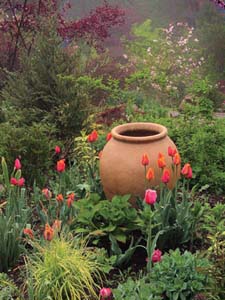Early Blooms in New England
Gardeners know winter really does end, and spring color always returns. Pansies, daffodils, and forsythia commonly herald the vernal transition, but still other blooms also contribute to a stunning early-season display. Here’s how three New England gardens host diverse plantings that strut their stuff in April and May. […]

Tulips pack the biggest punch around the Silk/Emery terrace in Farmington, Connecticut.
Photo Credit : Brown, RichardGardeners know winter really does end, and spring color always returns.
Pansies, daffodils, and forsythia commonly herald the vernal transition, but still other blooms also contribute to a stunning early-season display.
Here’s how three New England gardens host diverse plantings that strut their stuff in April and May.
Spring Bulbs
Garden designer and author Steve Silk loves to create lavish spectacles with bright-colored spring bulbs.
His wife, Kate Emery, shares his enthusiasm for eye-popping displays at their garden in Farmington, Connecticut. “We’re starved for color after winter’s monochromes,” Steve says, “so we’re not shy about using a bright palette.”
Each fall, Steve and Kate choose a different color scheme for the hundreds of tulips they plant. They strive to produce the most drama along the walkway leading from their driveway to a fieldstone terrace along the back of their Colonial-style home. One recent extravaganza featured yellow and fiery-orange tulips.
For photos and commentary, visit: clattervalleygardens.blogspot.com
Crabapple Majesty
The garden around Gordon and Mary Hayward‘s renovated circa-1770 farmhouse in Westminster West, Vermont, just north of Putney, relies on a sense of formality in its layout. An important aspect of this framework is an allee of crabapple trees. Serving as the entry into the garden, this symmetrical “orchard” invites visitors to enjoy a leisurely stroll.
In midspring, the crabapple trees they planted 15 years ago evoke an ethereal majesty when cloaked in their wispy blooms. “For me,” Gordon notes, “it’s an echo of my childhood growing up in an orchard in New Hartford, Connecticut.”
The Haywards chose three different varieties that bloom simultaneously in mid-May. Malus ‘Prairie Fire’ produces pinkish buds that open to whitish-pink blooms; ‘Sugar Tyme’ features pink buds that burst into fragrant white flowers; ‘Adams’ bears carmine buds that open into reddish-pink flowers.
The crabapples continue to earn their keep throughout the seasons, especially in winter, when the leafless trees add shapely architecture to this garden. Each variety also produces abundant fruit in shades of red. The small fruits start appearing in September and persist until a flock of cedar waxwings finishes them off in late March.
Growing beneath the trees are hardy geraniums, barrenworts, and a dark-red-leaved bugleweed, inspired by a design the couple saw at a garden in England’s Cotswold Hills, near where Mary grew up. A path of stepping stones provides access through the allee and is punctuated by a ‘Winter Gem’ boxwood in a large terra-cotta pot, another touch gleaned from British gardens.
The Haywards clearly enjoy merging influences from New England with those from “Old” England to create a welcoming garden that resonates with personal meaning.
For group tour dates, visit: haywardgardens.com
Native Plants
The entry garden that graces Honey Sharp‘s restored 1789 farmhouse in Great Barrington, Massachusetts, showcases spring blooms from subtle to showy. From the driveway, an iron gate opens to a path that meanders through a woodland and then melds into a sunny garden next to the front terrace. The varied light conditions let Honey, a garden designer, play with a wide-ranging palette of plants. She’s especially drawn to ones that tie in with the barn-red color she chose for her home.
In late spring, Honey’s sunny garden hosts various bulbs in burgundy, white, yellow, and orange. Tall-crown imperial fritillaries, with their pendant bell-shaped blooms, are among the most dramatic. Later, purple, burgundy, and white alliums, along with magenta and pink hardy geraniums and purple salvias, resonate harmoniously with the house and the rest of the garden.
An avid environmentalist, Honey especially likes connecting her cultivated garden to the surrounding landscape, which includes many acres of woodland. Her plantings continue to evolve through the growing season, with other perennials and certain shrubs in starring roles. She designed the area to be enjoyed from inside the house as well as outdoors. Honey and her husband, Dr. David Lippman, added a sunroom that connects to the kitchen, and with floor-to-ceiling windows, it affords a panoramic view of the garden all year long.
For photos and articles, visit: honeysharp.com
Gardens on Tour
Many regional gardens will be available for self-guided tours as part of The Garden Conservancy’s Open Days program. For more information and to obtain a directory of participating gardens, visit: gardenconservancy.org/opendays
More Specialty Gardens
Read about gardening with seaside species, moss, and native plants, and link to our sister publication, The Old Farmer’s Almanac All-Seasons Garden Guide.


